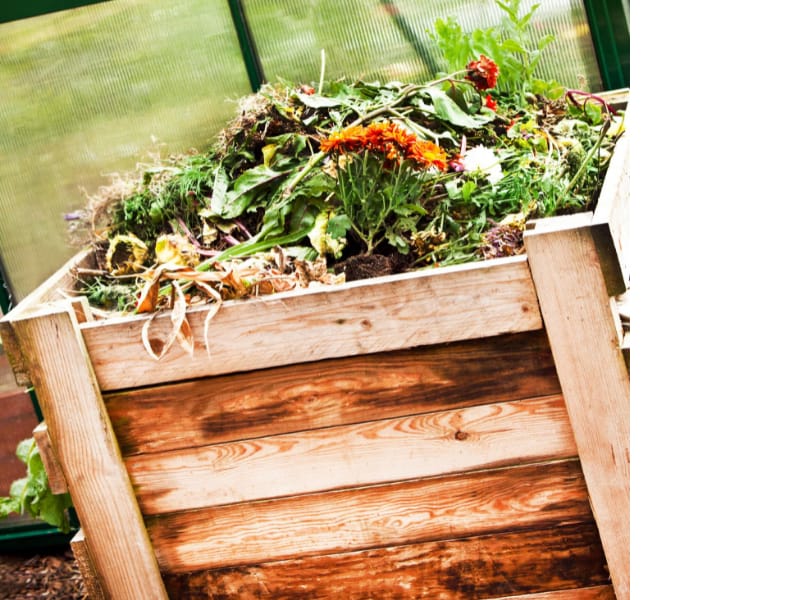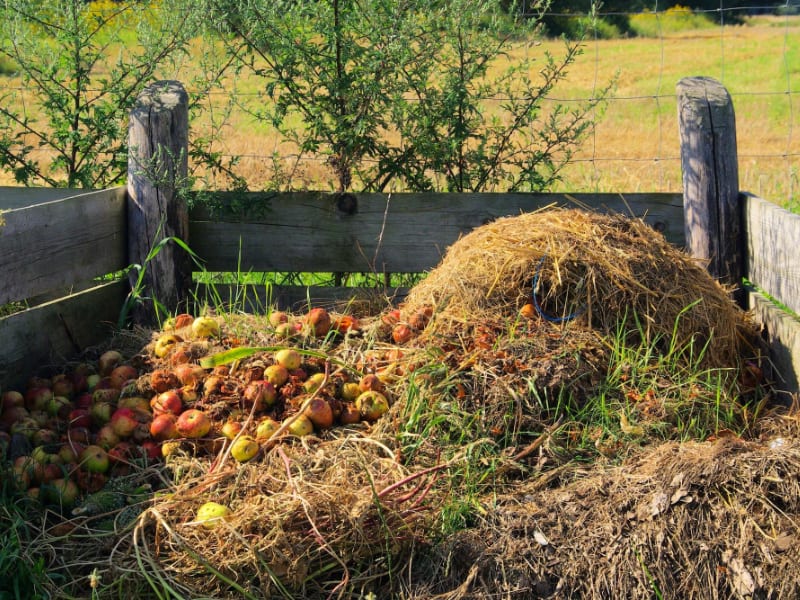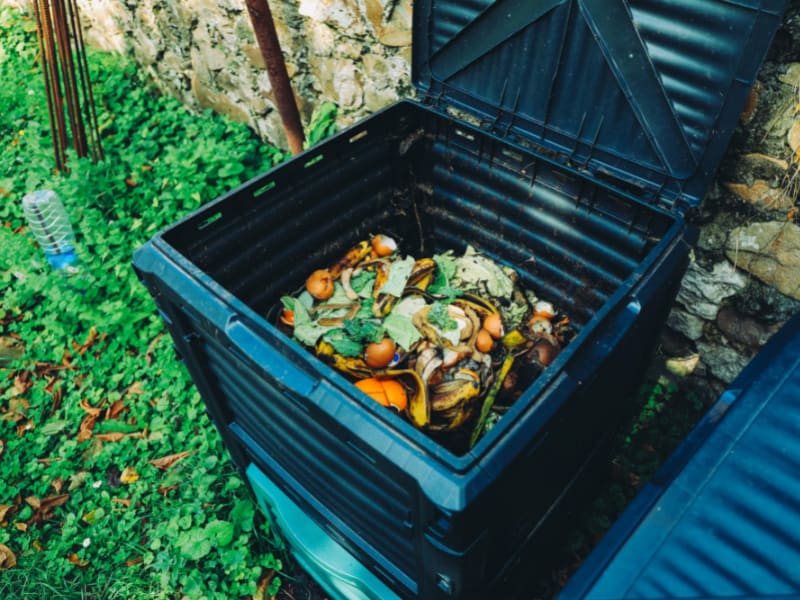There are many reasons why we should compost our food waste. It helps us save space, it reduces the amount of trash going to landfills, and it makes our gardens healthier.
The biggest question when getting started with composting is always – What can you compost? This article will help you figure out what you can compost and where to put the compost ingredients.
I’ve compiled a list of the most common items that you can compost. These include fruits, vegetables, coffee grounds, eggshells, bread, pasta, tea bags, paper towels, and even hair.
- Related article: What is Compost?
Brown and Green Ingredients Balance
Before getting into the list of ingredients, you’ll need to first know about brown and green materials. Organic material is composed of both brown and green materials. Both types of organic matter are needed for an optimal compost process.
Brown materials are things like leaves, grass clippings, sawdust, wood chips, etc., while green materials are things like fresh fruit and vegetable scraps, kitchen scraps, and yard trimmings.
It’s important to balance these two types of material in your compost because they have different effects on the soil. If you don’t have enough brown material, the soil won’t be able to hold nutrients as well.
On the other hand, if you don’t have enough green material, then there won’t be any oxygen for decomposition to occur.
So, before adding anything else to your compost bin, make sure that you have at least equal amounts of both brown and green compost materials.

What Can You Compost – 116 Compost Ingredients
For all the compostable materials listed, be sure to cut or shred larger items into small pieces so that they will compost more easily and quickly.
48 Ingredients from the Kitchen
Brown materials from the Kitchen:
- Cardboard boxes from cereal, pasta, etc.
- Cardboard egg cartons
- Cereal
- Coffee filters
- Corn cobs and stalks
- Crackers
- Crumbs from bread and rackers
- Crumbs from the bottom of snack food packaging
- Egg shells
- Nut shells (no walnut shells, as they are toxic to plants)
- Oatmeal
- Paper bags – Best to shred paper for compost
- Paper cupcake and muffin cups
- Paper napkins
- Paper plates
- Paper towels
- Paper towel cardboard rolls – Best to shred cardboard for compost
- Peanut shells
- Pizza boxes (unwaxed cardboard) – Learn the best way to compost pizza boxes.
- Popcorn kernels – Burned or unpopped
- Potato chips or tortilla chips
- Pizza crusts
- Pretzels
- Stale bread, pitas, or tortillas
- Tea bags – Only compost tea bags made of natural materials.
- Toothpicks – Wood
- Wine corks (chop up so they decompose faster)
- Wood or bamboo skewers (break them into pieces)
Green materials from the Kitchen:
- Food scraps – fruits and vegetables
- Avocado pits
- Banana peels
- Beer and wine
- Candy
- Cheese – Be careful of too much cheese and dairy in compost
- Coffee grounds
- Cooked pasta
- Cooked rice
- Corn husks
- Energy or protein bars
- Herbs and spices
- Ice cream
- Jam, jelly, or preserves
- Milk varieties – Almond, coconut, oat, rice, soy milk
- Pasta sauce or tomato paste
- Seaweed, kelp or nori
- Seeds – Pumpkin, sesame, or sunflower (best to cut these, so they don’t sprout)
- Tea leaves – Loose leaf tea
- Tofu and tempeh
26 Ingredients from Around the House
Brown materials from Around the House:
- Balloons – Latex only
- Burlap sacks
- Business cards – Not embossed or glossy cards.
- Colored paper
- Cotton clothing and jeans
- Cotton fabric scraps
- Cotton towels and sheets
- Crepe paper streamers
- Dryer lint – Only from clothes that were 100% natural fabrics.
- Dryer Sheets – Only biodegradable dryer sheets can be composted.
- Dust bunnies from hardwood and tile floors
- Dustpan contents of your dustpan (pick out any inorganic stuff, like pennies and Legos) (B)
- Envelopes – Remove the plastic window first.
- Junk mail – Non-glossy only. Remove the plastic windows and any glossy paper.
- Matches
- Natural potpourri
- Newspapers
- Paper bills and paper documents
- Paper table cloths
- Pencil shavings
- Rope and twine – Unwaxed and made of natural materials only.
- Sticky notes, Post-its
- Subscription cards from magazines
- Tissues
- Wool clothing
- Wrapping paper rolls
16 Ingredients from the Garden and Yard

When it comes to branches, trees, wood, and other yard waste, you may want to look at getting a wood chipper or shredder that will shred them to small pieces.
Brown materials from the Garden and Yard:
- Ashes from burned, untreated wood – Could be from the fireplace, grill, or outdoor fire pits.
- Christmas trees
- Dead leaves
- Dead plants
- Evergreen garlands
- Hay bales
- Holiday wreaths – Natural only.
- Used soil – as long as it did not hold a diseased or infected plant.
- Sawdust – Only from plain wood. Can’t be painted, pressure-treated, or stained wood.
- Straw
Green materials from the Garden and Yard:
- Leaves trimmed from houseplants
- Flowers from floral arrangements
- Grass clippings
- Pine Needles
- Pumpkins used for Jack O’lanterns
- Weeds
13 Ingredients from the Bathroom
Brown materials from the Bathroom:
- Condoms – 100% latex or lambskin
- Cotton balls – 100% cotton cotton balls
- Cotton swabs – 100% cotton and cardboard (not plastic) sticks
- Facial hair
- Facial tissues
- Hair
- Loofahs – natural ones
- Nail clippings
- Tampons and sanitary pads – 100% cotton ones
- Tampon applicators – cardboard ones
- Toilet paper rolls
Green materials from the Bathroom:
- Menstrual blood
- Urine
13 Ingredients that are Related to Pets
Brown materials Related to Pets:
- Alfalfa hay or pellets fed to hamsters, gerbils, rabbits, etc.
- Dry cat and dog food
- Feathers
- Fish food pellets
- Fur – Cats and dogs
Green materials Related to Pets:
- Bird droppings
- Cat litter
- Cat poop – Be careful of bacteria and pathogens. Learn to compost cat poop safely.
- Cow manure
- Dog poop – Be careful of bacteria and pathogens too. Learn to compost dog poop safely.
- Droppings and bedding from your herbivorous pet hamster, gerbil, rabbit, gerbil, etc.
- Goat manure
- Horse manure

Tips for Composting Materials
When composting materials, you shouldn’t just throw things onto your compost pile. Keep in mind these tips when composting:
- Organic waste is best broken down into smaller parts before adding to the compost heap. This helps break up the material and allows air to circulate more easily.
- Don’t add large amounts of wet material all at once. Add smaller quantities over time.
- Use a bucket with holes in the bottom so air can circulate through the pile. This helps ensure anaerobic conditions don’t develop.
- Make sure there is enough space on the surface of the pile. If it’s compacted down, it won’t heat up properly.
- Add a layer of straw, newspaper, or grass clippings between each addition of new materials. These helps keep a good brown and green material balance.
- If you’re using brown materials, make sure they aren’t contaminated by disease or pests. Make sure they’ve been treated if necessary.
- Keep track of what you put into your compost bin. This way you’ll know exactly how much of each ingredient you use.
What Can You Compost Final Thoughts
All in all, composting is a great way to recycle organic matter. It’s also a wonderful way to reduce the amount of garbage going into landfills. Finished compost can be used for your vegetable garden to grow tasty vegetables.
There are many different types of compost bins available, but one thing remains constant; composting is easy and fun!
Here are some other articles you might be interested in:

